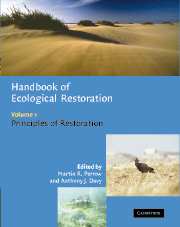Book contents
- Frontmatter
- Contents
- List of contributors
- Foreword
- Preface
- Part 1 The background
- Part 2 Manipulation of the physical environment
- Part 3 Manipulation of the chemical environment
- 9 Manipulating the chemical environment of the soil
- 10 Chemical treatment of water and sediments with special reference to lakes
- 11 Atmospheric chemistry
- Part 4 Manipulation of the biota
- Part 5 Monitoring and appraisal
- Index
- References
11 - Atmospheric chemistry
Published online by Cambridge University Press: 29 December 2009
- Frontmatter
- Contents
- List of contributors
- Foreword
- Preface
- Part 1 The background
- Part 2 Manipulation of the physical environment
- Part 3 Manipulation of the chemical environment
- 9 Manipulating the chemical environment of the soil
- 10 Chemical treatment of water and sediments with special reference to lakes
- 11 Atmospheric chemistry
- Part 4 Manipulation of the biota
- Part 5 Monitoring and appraisal
- Index
- References
Summary
INTRODUCTION
The impact of the atmosphere on life has been recognised since the earliest times. We need to breathe and this has always been obvious. The relation of plants to the atmosphere is more subtle. Pliny the Elder's Natural History (XXXI.29) shows early interest in damage to vegetation by salty rain in coastal environments. Roman agriculturists thought rainfall carried nutrients for vegetation, notions which persisted to the Middle Ages and fuelled debates on the spontaneous generation of life within rainwater. Stephen Hales recognised that plant leaves absorb air and a portion of this is used in nutrition. By the nineteenth century vast tracts of land had been destroyed by hydrogen chloride vapours from the alkali industry and Liebig and the workers at the fledgling experimental station at Rothamsted argued over the amount of nitrogen delivered to plants in rainfall. Despite this long history of the relationship between the atmosphere and ecosystems, the acid rain of recent decades has show how much remains to be resolved.
Here we will look at the way in which atmospheric trace composition is influenced by a delicate balance between sources and sinks. The underlying oxidative chemistry of the atmosphere means that compounds are often removed as soluble acidic compounds within rainfall. Changes imposed by human activities have been both profound and difficult to ameliorate.
- Type
- Chapter
- Information
- Handbook of Ecological Restoration , pp. 206 - 220Publisher: Cambridge University PressPrint publication year: 2002

